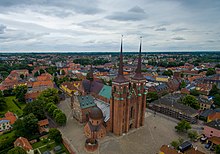
Back Catedral de Roskilde AST Роскільскі сабор Byelorussian Catedral de Roskilde Catalan Katedrála v Roskilde Czech Roskilde Domkirke Danish Dom zu Roskilde German Καθεδρικός Ναός του Ρόσκιλε Greek Katedralo de Roskilde Esperanto Catedral de Roskilde Spanish Roskilde toomkirik Estonian
| Roskilde Cathedral | |
|---|---|
Danish: Roskilde Domkirke | |
 View from the north-west | |
 | |
| 55°38′34″N 12°4′48″E / 55.64278°N 12.08000°E | |
| Location | Roskilde |
| Country | Denmark |
| Denomination | Church of Denmark |
| Previous denomination | Catholic Church |
| Website | www |
| History | |
| Status | Active |
| Dedication | Virgin Mary (formerly St Lucius and the Holy Trinity) |
| Consecrated | 1225 |
| Architecture | |
| Functional status | Cathedral |
| Heritage designation | protected monument 020410-79 |
| Architect(s) | Absalon, Peder Sunesen |
| Style | French Gothic, Dutch Renaissance, Neoclassicism, Byzantine Revival, Modernist |
| Groundbreaking | c. 1170 |
| Completed | 1636 |
| Specifications | |
| Length | 86 metres (282 ft) |
| Width | 27 metres (89 ft) |
| Height | 75.7 metres (248 ft)[1] |
| Number of towers | 2 |
| Number of spires | 2 |
| Administration | |
| Diocese | Roskilde |
| Clergy | |
| Bishop(s) | Ulla Thorbjørn Hansen |
| Criteria | Cultural: ii, iv |
| Reference | 695 |
| Inscription | 1995 (19th Session) |
Roskilde Cathedral (Danish: Roskilde Domkirke), in the city of Roskilde on the island of Zealand (Sjælland) in eastern Denmark, is a cathedral of the Lutheran Church of Denmark.
The cathedral is one of the most important churches in Denmark, and the official royal burial church of the Danish monarchs. It is also a UNESCO World Heritage Site. This is due to two criteria: the architecture of the cathedral shows 800 years of European architectural styles, and it is one of the earliest examples in Scandinavia of a Gothic cathedral to be built in brick; it encouraged the spread of the Brick Gothic style throughout Northern Europe. Constructed during the 12th and 13th centuries, the cathedral incorporates both Gothic and Romanesque architectural features in its design. The cathedral has been the main burial site for Danish monarchs since the 15th century. As such, it has been significantly extended and altered over the centuries to accommodate a considerable number of burial chapels and the many added chapels show different architectural styles.
The cathedral is a major tourist attraction, bringing in over 165,000 visitors annually. Since 1995, it has been listed as a UNESCO World Heritage Site due to its unique architecture. A working church, it also hosts concerts throughout the year.
- ^ "Roskilde Domkirke" (PDF) (in Danish). Historiefaget.dk. Archived from the original (PDF) on 14 September 2014. Retrieved 15 December 2014.